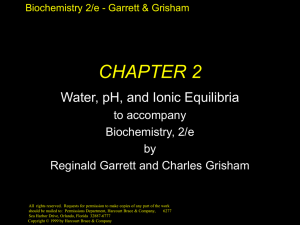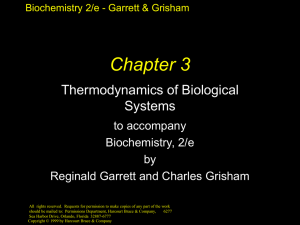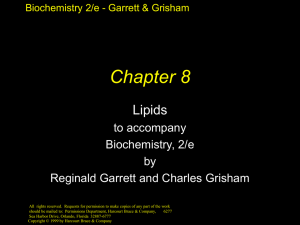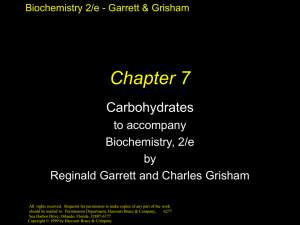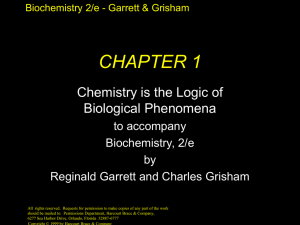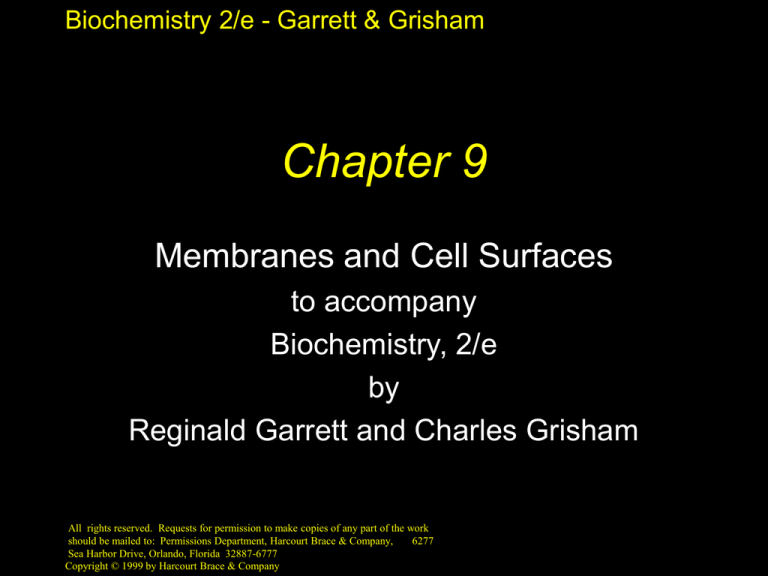
Biochemistry 2/e - Garrett & Grisham
Chapter 9
Membranes and Cell Surfaces
to accompany
Biochemistry, 2/e
by
Reginald Garrett and Charles Grisham
All rights reserved. Requests for permission to make copies of any part of the work
should be mailed to: Permissions Department, Harcourt Brace & Company,
6277
Sea Harbor Drive, Orlando, Florida 32887-6777
Copyright © 1999 by Harcourt Brace & Company
Biochemistry 2/e - Garrett & Grisham
Outline
• 9.1 Membranes
• 9.2 Structure of Membrane Proteins
• 9.3 Membrane and Cell-Surface
Polysaccharides
• 9.4 Glycoproteins
• 9.5 Proteoglycans
Copyright © 1999 by Harcourt Brace & Company
Biochemistry 2/e - Garrett & Grisham
9.1 Membranes
•
•
•
•
•
•
Structures with many cell functions
Barrier to toxic molecules
Help accumulate nutrients
Carry out energy transduction
Facilitate cell motion
Assist in reproduction
Modulate signal transduction
• Mediate cell-cell interactions
Copyright © 1999 by Harcourt Brace & Company
Biochemistry 2/e - Garrett & Grisham
Spontaneously formed lipid
structures
•
•
•
•
Hydrophobic interactions all!
Very few lipids exists as monomers
Monolayers arrange lipid tails in the air!
Micelles bury the nonpolar tails in the
center of a spherical structure
Micelles reverse in nonpolar solvents
Copyright © 1999 by Harcourt Brace & Company
Biochemistry 2/e - Garrett & Grisham
Copyright © 1999 by Harcourt Brace & Company
Biochemistry 2/e - Garrett & Grisham
Spontaneously formed lipid
structures
Hydrophobic interactions all!
• Lipid bilayers can form in several ways
– unilamellar vesicles (liposomes)
– multilamellar vesicles (Alex Bangham)
Copyright © 1999 by Harcourt Brace & Company
Biochemistry 2/e - Garrett & Grisham
Copyright © 1999 by Harcourt Brace & Company
Biochemistry 2/e - Garrett & Grisham
Copyright © 1999 by Harcourt Brace & Company
Biochemistry 2/e - Garrett & Grisham
The Fluid Mosaic Model
•
•
•
•
S. J. Singer and G. L. Nicolson
The phospholipid bilayer is a fluid matrix
The bilayer is a two-dimensional solvent
Lipids and proteins can undergo
rotational and lateral movement
Two classes of proteins:
– peripheral proteins (extrinsic proteins)
– integral proteins (intrinsic proteins)
Copyright © 1999 by Harcourt Brace & Company
Biochemistry 2/e - Garrett & Grisham
Copyright © 1999 by Harcourt Brace & Company
Biochemistry 2/e - Garrett & Grisham
Motion in the bilayer
• Lipid chains can bend, tilt and rotate
• Lipids and proteins can migrate ("diffuse")
in the bilayer
• Frye and Edidin proved this (for proteins),
using fluorescent-labelled antibodies
• Lipid diffusion has been demonstrated by
NMR and EPR (electron paramagnetic
resonance) and also by fluorescence
measurements
Copyright © 1999 by Harcourt Brace & Company
Biochemistry 2/e - Garrett & Grisham
Copyright © 1999 by Harcourt Brace & Company
Biochemistry 2/e - Garrett & Grisham
Membranes are Asymmetric
• Lateral Asymmetry of Proteins:
– Proteins can associate and cluster in the
plane of the membrane - they are not
uniformly distributed in many cases
• Lateral Asymmetry of Lipids:
– Lipids can cluster in the plane of the
membrane - they are not uniformly
distributed
Copyright © 1999 by Harcourt Brace & Company
Biochemistry 2/e - Garrett & Grisham
Copyright © 1999 by Harcourt Brace & Company
Biochemistry 2/e - Garrett & Grisham
Membranes are Asymmetric
• Transverse asymmetry of proteins
– Mark Bretscher showed that N-terminus of
glycophorin is extracellular whereas Cterminus is intracellular
• Transverse asymmetry of lipids
– In most cell membranes, the composition
of the outer monolayer is quite different
from that of the inner monolayer
Copyright © 1999 by Harcourt Brace & Company
Biochemistry 2/e - Garrett & Grisham
Copyright © 1999 by Harcourt Brace & Company
Biochemistry 2/e - Garrett & Grisham
Flippases
•
•
•
•
A relatively new discovery!
Lipids can be moved from one monolayer to
the other by flippase proteins
Some flippases operate passively and do
not require an energy source
Other flippases appear to operate actively
and require the energy of hydrolysis of ATP
Active flippases can generate membrane
asymmetries
Copyright © 1999 by Harcourt Brace & Company
Biochemistry 2/e - Garrett & Grisham
Copyright © 1999 by Harcourt Brace & Company
Biochemistry 2/e - Garrett & Grisham
Membrane Phase Transitions
•
•
•
•
The "melting" of membrane lipids
Below a certain transition temperature,
membrane lipids are rigid and tightly packed
Above the transition temperature, lipids are
more flexible and mobile
The transition temperature is characteristic
of the lipids in the membrane
Only pure lipid systems give sharp, welldefined transition temperatures
Copyright © 1999 by Harcourt Brace & Company
Biochemistry 2/e - Garrett & Grisham
Copyright © 1999 by Harcourt Brace & Company
Biochemistry 2/e - Garrett & Grisham
Copyright © 1999 by Harcourt Brace & Company
Biochemistry 2/e - Garrett & Grisham
9.2 Structure of Membrane
Proteins
Singer and Nicolson defined two classes
• Integral (intrinsic) proteins
• Peripheral (extrinsic) proteins
• We'll note a new one - lipid-anchored
proteins
Copyright © 1999 by Harcourt Brace & Company
Biochemistry 2/e - Garrett & Grisham
Peripheral Proteins
• Peripheral proteins are not strongly
bound to the membrane
• They can be dissociated with mild
detergent treatment or with high salt
concentrations
Copyright © 1999 by Harcourt Brace & Company
Biochemistry 2/e - Garrett & Grisham
Integral Membrane Proteins
• Integral proteins are strongly imbedded
in the bilayer
• They can only be removed from the
membrane by denaturing the membrane
(organic solvents, or strong detergents)
• Often transmembrane but not necessarily
• Glycophorin, bacteriorhodopsin are
examples
Copyright © 1999 by Harcourt Brace & Company
Biochemistry 2/e - Garrett & Grisham
Glyophorin
•
•
•
•
A single-transmembrane-segment protein
One transmembrane segment with globular
domains on either end
Transmembrane segment is alpha helical and
consists of 19 hydrophobic amino acids
Extracellular portion contains
oligosaccharides and these constitute the
ABO and MN blood group determinants
Mark Bretscher showed that glycophorin was
a transmembrane protein
Copyright © 1999 by Harcourt Brace & Company
Biochemistry 2/e - Garrett & Grisham
Copyright © 1999 by Harcourt Brace & Company
Biochemistry 2/e - Garrett & Grisham
Bacteriorhodopsin
A 7-transmembrane-segment (7-TMS) protein
• Found in purple patches of Halobacterium
halobium
• Consists of 7 transmembrane helical
segments with short loops that interconnent
the helices
• Note the symmetry of packing of bR (see
Figure 9.15)
• bR is a light-driven proton pump!
Copyright © 1999 by Harcourt Brace & Company
Biochemistry 2/e - Garrett & Grisham
Copyright © 1999 by Harcourt Brace & Company
Biochemistry 2/e - Garrett & Grisham
Copyright © 1999 by Harcourt Brace & Company
Biochemistry 2/e - Garrett & Grisham
Lipid-Anchored Proteins
A relative new class of membrane
proteins
• Four types have been found:
– Amide-linked myristoyl anchors
– Thioester-linked fatty acyl anchors
– Thioether-linked prenyl anchors
– Glycosyl phosphatidylinositol anchors
Copyright © 1999 by Harcourt Brace & Company
Biochemistry 2/e - Garrett & Grisham
Amide-Linked Myristoyl
Anchors
•
•
•
•
Always myristic acid
Always N-terminal
Always a Gly residue that links
Examples: cAMP-dependent protein
kinase, pp60src tyrosine kinase,
calcineurin B, alpha subunits of G
proteins, gag protein of HIV-1
Copyright © 1999 by Harcourt Brace & Company
Biochemistry 2/e - Garrett & Grisham
Copyright © 1999 by Harcourt Brace & Company
Biochemistry 2/e - Garrett & Grisham
Thioester-linked Acyl Anchors
• Broader specificity for lipids - myristate,
palmitate, stearate, oleate all found
• Broader specificity for amino acid links Cys, Ser, Thr all found
• Examples: G-protein-coupled receptors,
surface glycoproteins of some viruses,
transferrin receptor triggers and signals
Copyright © 1999 by Harcourt Brace & Company
Biochemistry 2/e - Garrett & Grisham
Thioether-linked Prenyl
Anchors
• Prenylation refers to linking of "isoprene"based groups
• Always Cys of CAAX (C=Cys, A=Aliphatic,
X=any residue)
• Isoprene groups include farnesyl (15-carbon,
three double bond) and geranylgeranyl (20carbon, four double bond) groups
• Examples: yeast mating factors, p21ras and
nuclear lamins
Copyright © 1999 by Harcourt Brace & Company
Biochemistry 2/e - Garrett & Grisham
Copyright © 1999 by Harcourt Brace & Company
Biochemistry 2/e - Garrett & Grisham
Glycosyl Phosphatidylinositol
Anchors
• GPI anchors are more elaborate than
others
• Always attached to a C-terminal residue
• Ethanolamine link to an oligosaccharide
linked in turn to inositol of PI
• See Figure 9.20
• Examples: surface antigens, adhesion
molecules, cell surface hydrolases
Copyright © 1999 by Harcourt Brace & Company
Biochemistry 2/e - Garrett & Grisham
Copyright © 1999 by Harcourt Brace & Company
Biochemistry 2/e - Garrett & Grisham
Copyright © 1999 by Harcourt Brace & Company
Biochemistry 2/e - Garrett & Grisham
Lipid Anchors are Signaling
Devices
• Recent evidence indicates that lipid
anchors are quite transient in nature
• Reversible anchoring and de-anchoring
can control (modulate) signalling pathways
• Similar to phosphorylation/
dephosphorylation, substrate binding/
dissociation, proteolytic cleavage triggers
and signals
Copyright © 1999 by Harcourt Brace & Company
Biochemistry 2/e - Garrett & Grisham
Bacterial Cell Walls
Composed of 1 or 2 bilayers and peptidoglycan shell
• Gram-positive: One bilayer and thick
peptidoglycan outer shell
• Gram-negative: Two bilayers with thin
peptidoglycan shell in between
• Gram-positive: pentaglycine bridge connects
tetrapeptides
• Gram-negative: direct amide bond between
tetrapeptides
Copyright © 1999 by Harcourt Brace & Company
Biochemistry 2/e - Garrett & Grisham
Copyright © 1999 by Harcourt Brace & Company
Biochemistry 2/e - Garrett & Grisham
Copyright © 1999 by Harcourt Brace & Company
Biochemistry 2/e - Garrett & Grisham
More Notes on Cell Walls
• Note the gamma-carboxy linkage of
isoglutamate in the tetrapeptide
• Peptidoglycan is called murein - from
Latin "murus", for wall
• Gram-negative cells are hairy! Note the
lipopolysaccharide "hair" in Figures 9.23
and 9.24
Copyright © 1999 by Harcourt Brace & Company
Biochemistry 2/e - Garrett & Grisham
Copyright © 1999 by Harcourt Brace & Company
Biochemistry 2/e - Garrett & Grisham
Copyright © 1999 by Harcourt Brace & Company
Biochemistry 2/e - Garrett & Grisham
Copyright © 1999 by Harcourt Brace & Company
Biochemistry 2/e - Garrett & Grisham
Cell Surface Polysaccharides
A host of important functions!
• Animal cell surfaces contain an incredible
diversity of glycoproteins and proteoglycans
• These polysaccharide structures regulate
cell-cell recognition and interaction
• The uniqueness of the "information" in these
structures is determined by the enzymes
that synthesize these polysaccharides
Copyright © 1999 by Harcourt Brace & Company
Biochemistry 2/e - Garrett & Grisham
9.4 Glycoproteins
•
•
•
•
Many structures and functions!
May be N-linked or O-linked
N-linked saccharides are attached via the
amide nitrogens of asparagine residues
O-linked saccharides are attached to
hydroxyl groups of serine, threonine or
hydroxylysine
See structures in Figure 9.26
Copyright © 1999 by Harcourt Brace & Company
Biochemistry 2/e - Garrett & Grisham
Copyright © 1999 by Harcourt Brace & Company
Biochemistry 2/e - Garrett & Grisham
O-linked Saccharides of
Glycoproteins
• Function in many cases is to adopt an
extended conformation
• These extended conformations resemble
"bristle brushes"
• Bristle brush structure extends functional
domains up out of the glycocalyx
• See Figure 9.27
Copyright © 1999 by Harcourt Brace & Company
Biochemistry 2/e - Garrett & Grisham
Copyright © 1999 by Harcourt Brace & Company
Biochemistry 2/e - Garrett & Grisham
Copyright © 1999 by Harcourt Brace & Company
Biochemistry 2/e - Garrett & Grisham
N-linked Oligosaccharides
Many functions known or suspected
• Oligosaccharides can alter the chemical and
physical properties of proteins
• Oligosaccharides can stabilize protein
conformations and/or protect against
proteolysis
• Cleavage of monosaccharide units from Nlinked glycoproteins in blood targets them for
degradation in the liver - see pages 287-289
Copyright © 1999 by Harcourt Brace & Company
Biochemistry 2/e - Garrett & Grisham
Copyright © 1999 by Harcourt Brace & Company
Biochemistry 2/e - Garrett & Grisham
Copyright © 1999 by Harcourt Brace & Company
Biochemistry 2/e - Garrett & Grisham
9.5 Proteoglycans
Glycoproteins whose carbohydrates are
mostly glycosaminoglycans
• Components of the cell membrane and
glycocalyx
• Consist of proteins with one or two
types of glycosaminoglycan
• See structures, Figure 9.31
Copyright © 1999 by Harcourt Brace & Company
Biochemistry 2/e - Garrett & Grisham
Copyright © 1999 by Harcourt Brace & Company
Biochemistry 2/e - Garrett & Grisham
9.5 Proteoglycans
• Example: syndecan - transmembrane
protein - inside domain interacts with
cytoskeleton, outside domain interacts
with fibronectin
Copyright © 1999 by Harcourt Brace & Company
Biochemistry 2/e - Garrett & Grisham
Copyright © 1999 by Harcourt Brace & Company
Biochemistry 2/e - Garrett & Grisham
Copyright © 1999 by Harcourt Brace & Company
Biochemistry 2/e - Garrett & Grisham
Proteoglycan Functions
• Modulation of cell growth processes
– Binding of growth factor proteins by
proteoglycans in the glycocalyx provides a
reservoir of growth factors at the cell surface
• Cushioning in joints
– Cartilage matrix proteoglycans absorb large
amounts of water. During joint movement,
cartilage is compressed, expelling water!
Copyright © 1999 by Harcourt Brace & Company
Biochemistry 2/e - Garrett & Grisham
Copyright © 1999 by Harcourt Brace & Company

